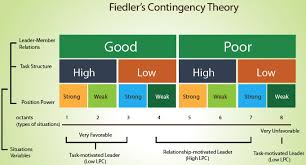
Situational Approach and Contingency Model of Leadership: A Tale of Two Coaches
Order Instructions:
Write a 500-750-word paper that analyzes the two leadership case studies found in topic materials for this module, “Coach Knight: A Will to Win” and “Coach K: A Matter of the Heart.”
Address the following questions and concepts:
Through your review of Fiedler’s contingency model, would you say that the coaches are matched to their situation? Why or why not? Has this had an impact on their effectiveness?
Provide evidence from the cases that show whether or not there is usage of the leadership styles by the two coaches, and adopt a position on whether or not you think the coaches are effective from this theoretical perspective.
Prepare this assignment according to the APA guidelines found in the APA Style Guide
SAMPLE ANSWER
Situational Approach and Contingency Model of Leadership: A Tale of Two Coaches
The contingency theory proposes that leaders base their style on prevailing situations. The theory classifies leaders into two classes. In the first category, leaders focus on task completion while in the second, they aim at building relationships with their subjects. The theory suggests that the best approach that leaders should take must fit their situations (Advise America, 2015). In his theory, Fiedler expressed leadership as fixed and measurable. Leaders can assess their qualities by evaluating their preference for both relationships and task completion (Schriesheim& Neider, 2012, Pg. 451).
Considering the contingency theory, the two managers adopted different leadership styles to fit their situations. Coach Knight for instance had to intimidate his players and push them to work harder, as he wanted to grab quick wins. By using dictatorial means, the coach made his players work hard and give no room to defeat. Though the method was not favorable for the players, the team was successful in most cases. Coach Knight was focused on winning, rather than enhancing his relationship with the players. He ensured that his players were disciplined through intimidation. The players adapted to his method by pursuing perfection, making them always determined to win. While his subjects could have disliked him for his dictatorship, they ended up liking him as he helped them achieve. In addition, the coach earned respect from the players through his style.
Coach K on the other hand focused on relationships with his players. His method was no less effective as he still registered high scores with his team. Coach K took an approach most preferred by managers in organizations. By pursuing relationships, the manager allowed his subjects to exercise self-drive, and ended up winning in most cases.Just like Coach Knight, his method was effective and appropriate for his situation.
According to the theory of contingency, leaders can either focus on relationship or task completion. Coach K focused on relationship, and hence exercised his leadership role. Coach Knight on the other hand focused on task completion, and just like Coach K, he performed his leadership duties.Coach K, for instance, associated with his players to strengthen his bond with them. He could even join them in activities outside the pitch, hence creating an interactive environment. He made his player free to express their views so that they could developed their own common goal. As a leader, he gained more influence by winning the trust of his subjects. The players could feel that he was part of them even when they were playing. The structure he created in his team was strong and players could automatically focus on winning.
On his side, Coach Knight maintained a power-oriented position in his team. Relationships were never his considerations, and he directly approached the core objective of his career; winning. when leaders adopt power, workers are likely to comply as followers (Wart, 2014, Pg. 160). By assuming a dictatorial approach, the coach forced the players to pursue excellence. It is an important responsibility for leaders to guide their subjects. In the authoritative mode of governance, leaders expect that employees work within the provided guidelines.
Conclusion
The theory of situational leadership significantly describes the styles taken by the two coaches. Though the two vectored in most situations, Coach K used a better style. While his counterpart’s style hurt the players’ emotions in some situations, Coach K’s method was encouraging and friendly. He not only attained victory, but also maintained good interactions with the players. With his strategies, Coach Knight achieved at the expense of relationship with his players.
References
Advise America. (2015). Fiedler’s Contingency Theory. Retrieved May 25, 2015 from http://www.adviseamerica.com/fiedler-contingency-theory-of-leadership/
Schriesheim, C. A., & Neider, L. L. (2012). Least Preferred Co-worker Theory. Sage, 451-453
Wart, M. V. (2014). Dynamics of Leadership in Public Service. Revised ed. Routledge
We can write this or a similar paper for you! Simply fill the order form!




